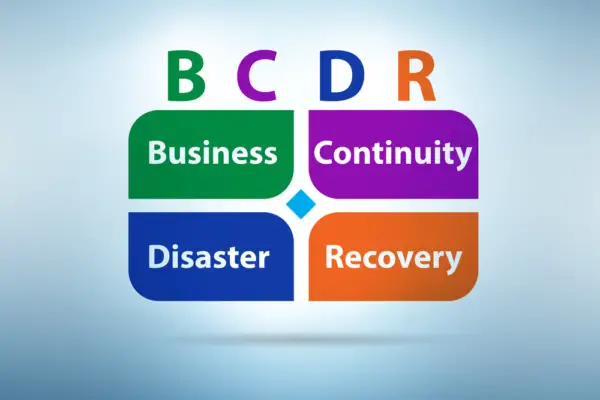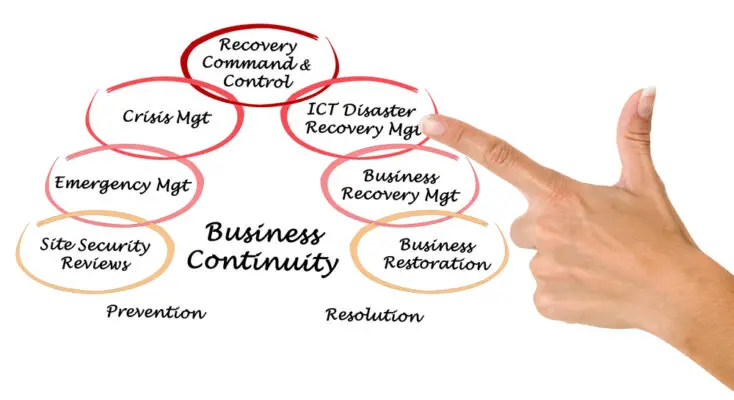The purpose of a Business Continuity Plan (BCP) is to provide a documented process that outlines how an organization will continue to operate during an unplanned disruption in service.
The plan is designed to minimize downtime and ensure that essential services can be provided to customers. A BCP helps an organization to prepare for and respond to a variety of disruptions, including natural disasters, cyber-attacks, and other unexpected events that could impact operations.
The plan typically includes procedures for all phases of recovery as defined in the Business Continuity Strategy.
The goal of a BCP is to minimize the impact of a disruption on an organization’s operations, reputation, and financial stability.
A Business Continuity Plan (BCP) aims to ensure that an organization can continue operating during a disruption, such as a natural disaster, cyber attack, or another emergency.
A BCP outlines procedures and instructions for how the organization will respond and recover from any potential threats.
It identifies time-sensitive or critical business functions and processes and the resources needed to support them.
Creating an effective BCP requires conducting a business impact analysis (BIA), which helps identify potential risks and develop strategies for mitigating those risks.
The plan should also include steps for communicating with employees, customers, vendors, and other stakeholders during an emergency.
Having a well-developed BCP in place can help organizations maintain operations during times of crisis and reduce downtime by quickly restoring services. This can help protect the organization’s reputation and minimize financial losses due to disruptions.
In today’s rapidly evolving and unpredictable business landscape, the importance of a robust business continuity plan cannot be overstated.
This essential tool ensures that an organization remains resilient despite unexpected challenges, safeguarding its reputation, financial stability, and overall operational efficiency.
In this blog post about”What is the Purpose of a Business Continuity Plan,” we will delve into the primary objectives of such a plan, exploring its significance in maintaining business continuity impact analysis and minimizing potential disruptions, ultimately enabling businesses to thrive amidst uncertainty.

The Benefits of Developing a Business Continuity Plan
A business continuity plan (BCP) is a comprehensive document that outlines how an organization should respond to unexpected events, such as natural disasters or pandemics.
Developing a BCP is essential for any business looking to protect its operations and minimize disruption in the event of an emergency. Let’s take a closer look at why having a BCP is so important.
It helps to ensure that the business can continue operations in the event of a disruption, such as a natural disaster, cyber-attack, or other emergencies. Developing a business continuity plan can help organizations reduce downtime and financial losses, protect their reputation, and maintain customer trust.
A comprehensive business continuity plan should include strategies for identifying potential risks, developing response plans for different types of disruptions, and regularly testing the plan to ensure it remains up-to-date and effective.
It should also include procedures for restoring operations quickly after an incident occurs.
Organizations should also consider how they communicate with employees and customers during a disruption.
Having clear communication protocols in place can help minimize confusion and ensure everyone knows the steps to restore operations.
What Does a BCP Do?
A BCP helps organizations prepare for potential disruptions. It identifies potential risks and threats and outlines preventive measures that can be taken to reduce the likelihood of these events occurring.
It also provides detailed instructions on responding if an event occurs, including which personnel are responsible for taking specific actions and when those should be taken.
Business continuity planning (BCP) is essential to any organization’s disaster recovery strategy. A BCP aims to identify potential risks and disruptions that could adversely affect more normal business operations and then develop strategies to prevent or mitigate those risks.
A well-developed BCP will help protect the organization’s assets, personnel, revenues, and reputation in the event of an emergency.
The activities involved in creating and maintaining a BCP will vary depending on the size of the organization’s business functions and risk profile. However, some common components include:
Establishing mission-critical functions for operations that must remain active during times of crisis
Identifying alternative resources (humans and technology) that can be used if the primary resource is unavailable
Creating policies related to communications during crises
Developing procedures for restoring operations after an incident has occurred
Establishing testing scenarios to ensure the continued effectiveness of plans over time
Business continuity planning is essential for ensuring businesses are able not just to survive disruptive events but also thrive despite them.
The Benefits of Having a BCP
A well-developed BCP offers several key benefits for organizations of all sizes. First, it allows organizations to respond quickly to emergencies without wasting time or resources trying to figure out what needs to be done at the moment.
This helps them minimize losses due to downtime and disruption while ensuring they can still meet customer demands when needed.
Additionally, having a BCP in place helps organizations demonstrate their commitment to safety and compliance by demonstrating that they have taken proactive steps to reduce risk and ensure their operations remain resilient in the face of unforeseen events.
Finally, having a BCP also ensures that critical processes remain operational during times of crisis, which can help maintain employee morale and reduce stress levels during challenging times.
Disasters often strike with little warning. Even when a preemptive warning was given, various factors could lead to the greatest of intentions and mistakes when faced with a disaster.
Every incident and the goals of preparing for an incident can help your business respond with an effective response strategy. This article explains why you should have a business continuity plan in place.
Business Continuity Plan Objectives Aligned to Template
We’ve aligned our objectives and recommendations with the template for the Ready.gov BusinessContinuity Plan. Prepare.gov is an organization within the Federal Emergency Management Agency (FEMA).
The agency’s mission is to distribute materials to improve nationwide response times in emergencies such as natural and manmade disasters.
Some sections of business-related information technology front pages include a BusinessContinuum Plans Template.
The business continuity planning risk assessment process is a crucial component of a company’s overall risk management strategy, designed to ensure the organization’s resilience in the face of unforeseen disruptions.
This systematic approach to critical data involves identifying potential threats, assessing their potential impact on critical business functions, and developing comprehensive strategies to mitigate risks and minimize downtime.
Business continuity management (BCM) encompasses developing, implementing, and maintaining these plans and coordinating resources and communication efforts during an incident.
Integrating business continuity management into the planning process helps companies better protect their operations, and assets, and maintain a competitive edge in an unpredictable business landscape.
Resource Required to Support Recovery Strategies
Recovery of critical processes requires resources. Business continuity needs resource needs worksheet. What is required for a manager to complete the business processes?
Completed worksheets are used to determine the resources needed to restore business functions and recovery strategies.
In a business situation involving a faulty system or unforeseen equipment, performing a recovery plan or regaining normal operations will be necessary.
The resource can originate in a particular business unit or be provided by third-party sources.
What are the objectives of business continuity planning
We now know why business continuity plans are essential, but the terms business continuity and disaster recovery planning are distinct.
In a typical situation, disasters are related to a technology function in your business. Business continuity versus disaster recovery: A Disaster Recovery Plan is essential to your business continuity program.
Identify critical business functions: Determine the essential processes and resources required for an organization to continue operating during and after a disruption.
Minimize downtime: Develop strategies to reduce the duration and impact of disruptions on the organization, ensuring a faster recovery and return to normal operations.
Protect organizational assets: Safeguard the organization’s physical, financial, and intellectual property assets, as well as its reputation, by preventing or minimizing damage from disruptions.
Ensure employee safety: Establish procedures to protect the well-being of employees during and after a disruptive event, including communication, evacuation, and shelter-in-place plans.
Maintain customer confidence: Develop and implement strategies to ensure customer satisfaction and service delivery during and after disruptions, thereby preserving trust and loyalty.
Ensure regulatory compliance: Adhere to legal, financial industry regulatory authority, and industry-specific business continuity planning and risk management requirements.
Continual improvement of business continuity institute: Regularly review, test, and update business continuity plans to ensure their effectiveness and alignment with the organization’s changing needs, risks, and objectives.
Three key components of a business continuity plan
Business continuity plans mainly comprise three key components: Resiliency, Recovery, and contingencies. A company can improve its resilience by designing critical infrastructures with different disaster scenarios, including staffing rotation, data center redundancy, or keeping surplus capacity for a particular function.
Resilience can also aid in maintaining essential services at the site and outside sites without disruption. The recovery of businesses from disasters must be swift.
Setting recovery time targets can help determine the best components to recover first.
A business continuity plan (BCP) is a comprehensive document that outlines the strategies and procedures an organization will follow in the event of a disruption. The three key components of a BCP include:
Business Impact Analysis (BIA):
This component involves identifying the organization’s critical business functions, processes, and resources and determining their recovery time objectives (RTOs) and recovery time objectives or point objectives (RPOs).
The BIA helps prioritize recovery efforts and allocate resources appropriately, restoring the most critical functions as quickly as possible.
Recovery Strategies
These are the specific plans and procedures an organization will follow to recover and restore critical business functions after a disruption.
Recovery strategies typically address aspects such as data backup and disaster recovery solutions, alternate work locations, resource requirements, communication protocols, and the roles and responsibilities of personnel during the recovery process.
Testing, Training, and Maintenance:
Regular testing and training are essential to ensure that the BCP remains effective, up-to-date, and well-understood by all relevant personnel. Testing typically involves conducting simulations.
Exercises or tabletop discussions evaluate the plan’s effectiveness, while training ensures that employees are familiar with their roles and responsibilities during an incident.
Regular maintenance involves updating the BCP as the organization’s needs, risks, and priorities change.
Why is business continuity important?
Business continuity is important for several reasons, as it helps organizations maintain essential functions during and after unexpected events or disruptions. Ensuring business continuity allows organizations to recover critical business functions:
- Protect revenue and reputation: By minimizing downtime and maintaining critical operations, organizations can prevent financial losses and preserve their reputation in the eyes of customers, investors, and stakeholders.
- Ensure legal and regulatory compliance: Many industries have laws and regulations requiring organizations to implement business continuity plans to protect sensitive data, safeguard customer information, and maintain essential services.
- Improve customer trust and confidence: A robust business continuity plan demonstrates a company’s commitment to maintaining uninterrupted services, which can enhance customer loyalty and trust.
- Reduce recovery time: Business continuity plans include processes for quickly recovering and restoring normal operations after a disruption, which minimizes the impact on the organization’s productivity and performance.
- Enhance risk management: Identifying potential risks, assessing their impact, and developing mitigation strategies are essential to business continuity planning. This helps organizations to be more resilient and better prepared for unforeseen events.
- Maintain supply chain integrity: A well-developed business continuity plan can help an organization identify vulnerabilities in its supply chain and implement strategies to minimize the risk of disruptions, ensuring the timely delivery of products and services.
- Protect employees: Business continuity planning ensures employees are prepared for emergencies with clear communication channels.
In times when downtime is not acceptable, it is critical to ensure optimal business operations. Downtime can come from many different sources.
The threat to the economy has increased in recent months. Business continuity plans must consider potential disruptions to the whole business process.
The plan helps organizations to run if needed during an emergency if necessary. The company maintains a business continuity team to provide rapid response to interruptions.
The importance of business continuity is vital for the success of your organization. Long outages can lead to financial, personal, and reputation damage.
How to test business continuity plans
You should try several tests to determine how much of an effective strategy you have in mind.
In fact, it is important to look at the most important details that affect the plan, like a correct contact number and email.
It takes considerable time to locate the right number, ultimately delaying responding to the crisis.
Conclusion
An effective business continuity plan is essential for any organization looking to stay competitive and resilient in today’s ever-changing world.
A good BCP will help your organization identify potential risks and threats, minimize disruption, stay compliant with safety standards, maintain customer satisfaction, and keep morale high even during challenging times.
Investing the time now into developing your own comprehensive business continuity plan will pay off in the future.

Chris Ekai is a Risk Management expert with over 10 years of experience in the field. He has a Master’s(MSc) degree in Risk Management from University of Portsmouth and is a CPA and Finance professional. He currently works as a Content Manager at Risk Publishing, writing about Enterprise Risk Management, Business Continuity Management and Project Management.



